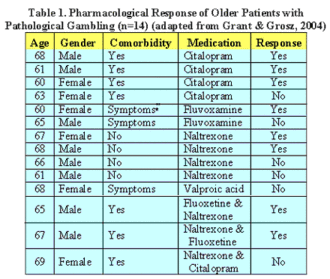Several recent WAGERs (e.g., WAGERs 8(37), 8(21)) have highlighted advances in the pharmacological treatment of addictive behaviors. Whereas existing studies generally focus on a wide population base, fewer studies have examined the usefulness of pharmacotherapy among specific groups of problem gamblers. In an effort to address the paucity of research in this area, Grant and Grosz (2004) recently conducted the first assessment of pharmacological response among older problem gamblers. This week’s WAGER examines the results of this preliminary study.
Grant and Grosz (2004) studied 14 (6 female) consecutive patients aged 60 or older who presented for outpatient pathological gambling treatment at the first author’s clinical practice. All subjects met DSM-IV (American Psychiatric Association, 1994) criteria for pathological gambling. To determine psychiatric comorbidity, the authors screened all subjects for a wide range of disorders: mood, anxiety, substance use, impulse control, psychotic, eating, antisocial personality, and borderline personality. Psychiatric comorbidity qualified treatment plans, but did not prevent participation in the study. Depending on individual clinical assessment, patients received either naltrexone, a medication commonly used to treat opioid and alcohol dependence, or an antidepressant (e.g., citalopram, fluoxetine) as a primary therapeutic agent to reduce pathological gambling. Some patients received naltrexone and an antidepressant depending on the complexity of their diagnosis.
The authors evaluated subjects’ response to medication (i.e., reduction in urge to gamble) using the 7-point Clinical Global Impressions Scale for Pathological Gambling (PG-CGI; Guy, 1976). They compared subjects’ baseline (i.e., initial visit) PG-CGI score with PG-CGI pharmacotherapy response ratings at two month intervals through the duration of follow-up1 (mean = 425.4 ± 285.1 days). “Responders” to treatment were subjects who scored “1” or “2” (i.e., much or very much improvement) on the PG-CGI for at least two consecutive follow-up periods and did not worsen throughout the course of follow-up. Eight (57.1%) of the fourteen subjects responded to medication and exhibited no or minimal gambling behavior or urges to gamble at follow-up (see Table 1). In these eight cases, the medication required an average of 124 days to trigger a response.
* Subject exhibited symptoms, but did not meet full criteria for comorbid disorder.
These results suggest that older subjects might respond favorably to pharmacological treatment of pathological gambling; however, because this is a preliminary study, there are several methodological limitations. As noted by the authors, the sample size was very small. Future studies should include larger, scientifically representative samples. In addition, this study did not utilize a comparison (i.e., control) group. A control group is necessary because a similar favorable response rate might result from placebo treatment or no treatment. Additional research should employ double-blind, placebo-controlled clinical trials to more fully understand the effects of specific pharmacotherapies on pathological gambling. The authors also chose to measure the impact of multiple medications, sometimes used in tandem; however, indepth study of the effects of a single drug might have presented a more meaningful relationship with changes in disordered gambling behavior. Further, the PG-CGI only measures changes in gambling symptoms, and does not monitor changes in comorbid conditions. Future studies should attempt to delineate between improvement in gambling behavior attributable to pharmacological treatment and improvement attributable to changes in comorbid symptoms. Finally, the current sample included only subjects aged 60-69. Studying “older” subjects (i.e., age 70 and older) could provide additional evidence on the efficacy of pharmacological treatment of pathological gambling among the elderly.
The development of pharmacological treatment approaches for pathological gambling provides hope for those struggling with disordered gambling and offers a potentially useful treatment alternative or adjunct to doctors. Studying the specific effects of pharmacotherapy among older gamblers is especially important: many retirees live on a fixed income and have large amounts of time available to partake in gambling activities, potentially putting them at increased risk for developing gambling problems. Pharmacological therapies have the capacity to help older people who might be resistant to more traditional forms of gambling treatment (e.g., cognitive behavioral therapy or Gamblers Anonymous). With additional research, pharmacotherapy holds the promise to become an integral component of treating gambling disorders among the elderly, other vulnerable populations and the general population.
Comments on this article can be addressed to Tony Donato.
Notes
1 Patients remained in follow-up for the duration of their pharmacological treatment. At the time of the article’s publication, eight subjects remained in follow-up and six subjects had dropped out of the study.
References
American Psychiatric Association. (1994). DSM-IV: Diagnostic and statistical manual of mental disorders (Fourth ed.). Washington, D.C.: American Psychiatric Association.
Grant, J. E., & Grosz, R. (2004). Pharmacotherapy outcome in older pathological gamblers: A preliminary investigation. Journal of Geriatric Psychiatry & Neurology, 17(1), 9-12.
Guy, W. (1976). ECDEU assessment manual for psychopharmacology. U.S. Department of Health, Education and Welfare publication (ADM) 76-338. Rockville, MD: National Institute of Mental Health.





